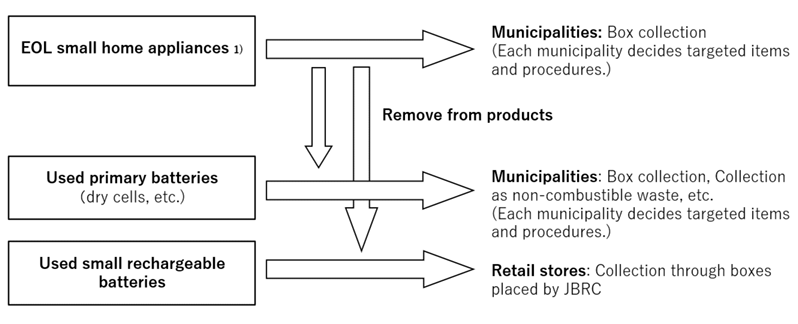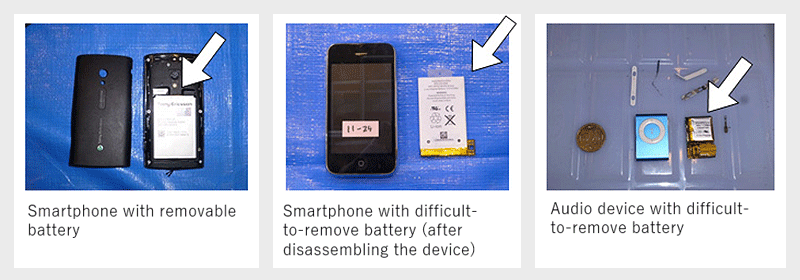- Waste management in Japan
- Circular economy in Japan
- Waste management in Asia
- Disaster waste management
Collection and Recycling of Batteries in Small Home Appliances in Japan
End-of-life electrical equipment and batteries
In Japan, collection and recycling of end-of-life (EOL) electrical equipment have been promoted to achieve proper resource circulation as well as reduction of loads at waste treatment facilities. Japan’s Home Appliance Recycling Act came into force in 2001 covering four large items (generally called “four types of home appliances,”) namely TVs, air conditioners, refrigerators/freezers and washing machines/dryers. Under this Act, a mechanism was established obliging retailers to collect EOL products from consumers who pay designated recycling fees when replacing these items.
At that time, most other relatively smaller EOL home appliances (referred to as “EOL small home appliances” in this article) were collected by municipalities as non-combustible or bulky waste except for those collected by certain industry associations through their own collection systems. To promote their recycling, the Act on Promotion of Recycling of Small Waste Electrical and Electronic Equipment (abbreviated as "the Small Home Appliance Recycling Act") was brought into effect in 2013. This Act has obliged each municipality to collect EOL small home appliances according to its own target items and collection procedures. For example, previously, industry associations for mobile phones had mainly collected EOL products at retail stores through a system called “Mobile Recycle Network,” but an increasing number of municipalities have also started to collect EOL small home appliances to comply with the Act.
Many EOL small home appliances contain batteries. Most municipalities collecting these appliances request consumers to take out batteries before disposing of the products. Some batteries can be easily removed by hand or simple tools, but others cannot. We conducted a survey in a municipality to know what types of EOL small home appliances are discarded at collection boxes and which ones contain batteries. The results showed that removable batteries were used in more than 90% of the products surveyed including mobile phones, digital cameras, radios, and remote controls, though difficult-to-remove batteries were used in rare cases. Removing them before disposing of products is very important to prevent fire incidents and promote proper recycling, but we found that only half of the products surveyed were disposed of after removing batteries. In particular, the battery removal rate was merely 22% in the case of mobile phones. If you dispose of EOL small home appliances through designated collection systems, please make sure to remove batteries beforehand.
Collection of removed batteries
Then, how should we dispose of the batteries removed from EOL small home appliances? Generally, used primary batteries, such as dry cells, are supposed to be brought to municipal offices, and used small rechargeable batteries are to be brought to the collection boxes placed at retail stores by a battery industry association, Japan Portable Rechargeable Battery Recycling Center (JBRC) (Fig. 1). However, even if you bring the EOL small home appliances to your municipality’s collection boxes, you may rarely find battery collection boxes at the same location. To make matters more complicated, collection boxes for primary batteries and those for small rechargeable batteries are often placed at different sites. Therefore, consumers are advised to remove batteries at home as much as they can before disposing of EOL small home appliances. At present, those municipalities and industry associations responsible for treatment and recycling of EOL small home appliances and used batteries individually decide collection procedures that are convenient for them. In future, however, it is desirable that collection boxes for these appliances and batteries be placed at the same site in order to increase the collection rate.

Increasing number of lithium-ion batteries and future recycling of batteries
Now, let us think about recycling of batteries per se regardless of whether or not they are removable. Previously, small rechargeable batteries such as nickel-cadmium (Ni-Cd) and nickel–metal hydride (Ni–MH) batteries were often used for small home appliances. However lately, lithium-ion (Li-ion) batteries have been increasingly used for these products. Indeed, most personal computers and mobile phones use Li-ion batteries. In the case of Ni-Cd batteries, treatment of a hazardous metal, cadmium, was the main issue. Likewise, in the case of Li-ion batteries, safety and recycling of metals such as nickel and cobalt require special attention.
Unlike the products with removable batteries that I mentioned earlier, some small home appliances use Li-ion batteries that are difficult to remove (Fig. 2). Inappropriately produced or handled Li-ion batteries are known to cause a fire. Under the Japanese Fire Service Act, electrolyte solution contained in Li-ion batteries is considered to be a hazardous material (i.e., inflammable liquid) that has a fire risk as high as petroleum liquids. The Act obliges high volume Li-ion battery production or storage facilities to take certain fire prevention and safety measures as the facilities handling hazardous materials.
Damaging Li-ion batteries is dangerous. Thus, consumers are requested to refrain from removing them by force when their removal is difficult. Recycling facility operators are also requested to secure much higher level of safety when they break up or crush Li-ion batteries. Recycling with improved safety and resource recovery is required in future for used Li-ion batteries in EOL small home appliances.

(White arrows indicate lithium-ion batteries)
For more information
- Terazono A., Oguchi M., Iino S., Mogi S. (2015) Battery Collection in Municipal Waste Management in Japan: Challenges for Hazardous Substance Control and Safety. Waste Management, 39, 246-257
- Terazono A. (2013) Recycling Small Home Appliances and Metals in Japan, NIES Material Cycles Division online magazine.


